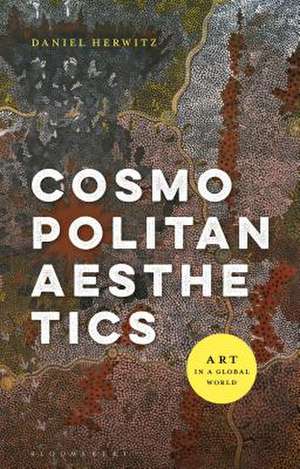Cosmopolitan Aesthetics: Art in a Global World
Autor Daniel Herwitzen Limba Engleză Paperback – 11 dec 2019
| Toate formatele și edițiile | Preț | Express |
|---|---|---|
| Paperback (1) | 164.59 lei 3-5 săpt. | |
| Bloomsbury Publishing – 11 dec 2019 | 164.59 lei 3-5 săpt. | |
| Hardback (1) | 496.37 lei 6-8 săpt. | |
| Bloomsbury Publishing – 11 dec 2019 | 496.37 lei 6-8 săpt. |
Preț: 164.59 lei
Preț vechi: 205.08 lei
-20% Nou
Puncte Express: 247
Preț estimativ în valută:
31.49€ • 34.32$ • 26.54£
31.49€ • 34.32$ • 26.54£
Carte disponibilă
Livrare economică 02-16 aprilie
Preluare comenzi: 021 569.72.76
Specificații
ISBN-13: 9781350075245
ISBN-10: 1350075248
Pagini: 232
Ilustrații: 15
Dimensiuni: 138 x 216 x 16 mm
Greutate: 0.27 kg
Editura: Bloomsbury Publishing
Colecția Bloomsbury Academic
Locul publicării:London, United Kingdom
ISBN-10: 1350075248
Pagini: 232
Ilustrații: 15
Dimensiuni: 138 x 216 x 16 mm
Greutate: 0.27 kg
Editura: Bloomsbury Publishing
Colecția Bloomsbury Academic
Locul publicării:London, United Kingdom
Caracteristici
An introduction to core questions, problems and arguments in contemporary aesthetics, assuming no prior knowledge of philosophy
Notă biografică
Daniel Herwitz is Fredrick Huetwell Professor of Philosophy, History of Art and Comparative Literature at the University of Michigan, USA where for a decade he directed the Institute for the Humanities. His previously published books include Aesthetics, Arts and Politics in a Global World (2017), the award winning Star as Icon (2008), and M.F. Husain (1988). Herwitz frequently writes for galleries in New York City, London, Cape Town and other places.
Cuprins
AcknowledgementsList of FiguresHow to Use This Book1. Introduction to Globalization 2. The Global Art World Today: Problems and Prospects 3. Aesthetic Cosmopolitanism 4. Cultural Property and Aesthetic Synergy5. Meaning and Medium in Art6. Taste in its 18th Century Context 7. Aesthetic Judgment from a Cosmopolitan PerspectiveBibliography Index
Recenzii
"This book asks how one can reconcile the universalizing theories of post-Enlightenment aesthetics with the current realities of a globalized economy. Herwitz's answer, in short: cosmopolitanism, a dialectic of homogenization and diversity. [He] reconsiders the relationship of contemporary art to sociopolitical events and institutions by circling back to the 18th and 19th centuries of Kant and Hegel and then to Danto in the 20th century. These philosophical inquiries are interleaved with case studies of specific artists, many of whom hail from the Global South and thus provide welcome counterbalance to the still-dominant First World narrative. In Herwitz's telling, 21st-century artistic cosmopolitanism also sheds new light on historical aesthetics, providing a means for reevaluating how the personal and the universal were reconciled in aesthetic theory. These are big, unwieldy topics and Herwitz's clear, conversational style makes the material accessible. That said, it is inevitable that a subject of such scope leaves much territory unexamined and a great deal of art unaccounted for . The book provides a useful introduction to issues of globalization as it pertains to art. Summing Up: Recommended. Lower- and upper-division undergraduates; graduate students.
This book far extends the usual scope of aesthetic enquiry. It is written with a challenge, to open up the political and social imaginary through the historical and contemporary media of the arts. Its flair and wit, its insight and extensive range raises the stakes in a world market whose design threatens to close down and restrict the promise of the cosmopolitan who refuses any longer to be a colonialist.
Daniel Herwitz, one of our great authorities on the discipline of Aesthetics, here turns his attention to the ways the question of cosmopolitanism, first put forward by Kant and then called into question by Hegel and others, can-indeed must-- be adapted today if we are to make sense of art practice and reception as these intersect with the global art market. Designed for the general reader as well as for art historians and critics, Cosmopolitan Aesthetics is that rare thing-a truly necessary book.
The world according to Daniel Herwitz is endlessly rich, beautiful, and troubled. Cosmopolitan Aesthetics is perhaps his most important book to date, combining his unique philosophical command, political commitment, and aesthetic judgment with his signature electric wit. The result is a riveting and indispensable analysis of art, commerce, and taste in the post-global age.
This book far extends the usual scope of aesthetic enquiry. It is written with a challenge, to open up the political and social imaginary through the historical and contemporary media of the arts. Its flair and wit, its insight and extensive range raises the stakes in a world market whose design threatens to close down and restrict the promise of the cosmopolitan who refuses any longer to be a colonialist.
Daniel Herwitz, one of our great authorities on the discipline of Aesthetics, here turns his attention to the ways the question of cosmopolitanism, first put forward by Kant and then called into question by Hegel and others, can-indeed must-- be adapted today if we are to make sense of art practice and reception as these intersect with the global art market. Designed for the general reader as well as for art historians and critics, Cosmopolitan Aesthetics is that rare thing-a truly necessary book.
The world according to Daniel Herwitz is endlessly rich, beautiful, and troubled. Cosmopolitan Aesthetics is perhaps his most important book to date, combining his unique philosophical command, political commitment, and aesthetic judgment with his signature electric wit. The result is a riveting and indispensable analysis of art, commerce, and taste in the post-global age.
